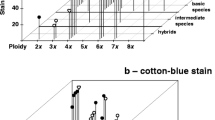Abstract
Two pollen stainability tests (Alexander’s stain and acetocarmine) were used to detect differences in pollen viability of the sexual, apomictic and sterile plants of Hieracium subgen. Pilosella. In sexual taxa (Hieracium bauhini and H. densiflorum), the average stainability was 93.7–98.4%. Similarly high stainability (92.2–97.2%) was found in the apomictic Hieracium pilosellinum and in the majority of the apomictic populations (or plants) of the pentaploid and hexaploid H. bauhini. In some apomictic plants of Hieracium bauhini the average pollen stainability was 49.0–75.4%. The lowest pollen stainability was found in the sterile plants, i.e. the triploid H. pistoriense (33.6%) and the pentaploid H. brachiatum (29.6%).
Similar content being viewed by others
References
Alexander M.P. 1969. Differential staining of aborted and nonaborted pollen. Stain Technol. 44: 117–122.
Alexander M.P. 1980. A versatile stain for pollen, fungi, yeast, and bacteria. Stain Technol. 55: 13–18.
Aparicio A. 1994. Karyological studies in Hieracium baeticum (Asteraceae) from the “Parque Natural de la Sierra de Grazalena” (Souther Spain). Flora Mediterranea 4: 25–34.
Báez P., Riveros M. & Lehnback C. 2002. Viability and longevity of pollen of Notofagus species in south Chile. New Zealand J. Bot. 40: 671–678.
Bicknell R.A. 1997. Isolation of a diploid, apomictic plant of Hieracium aurantiacum. Sexual Pl. Reprod. 10: 168–172.
Bolat I. & Pirlak L. 1999. An investigation of pollen viability, germination and tube growth in some stone fruits. Tr. J. Agr. Forest. 23: 383–388.
Busch J.W. 2005. Inbreeding depression in self-incompatible and self-compatible populations of Leavenworthia alabamica. Heredity 94: 159–165.
Chapman H.M. & Bicknell R.A. 2000. Recovery of a sexual and an apomictic hybrid from crosses between the facultative apomicts Hieracium caespitosum and H. prealtum. New Zealand J. Ecol. 24: 81–86.
Chrtek J. jun. 1997. Taxonomy of the Hieracium alpinum group in the Sudeten Mts., the West and the Ukrainian East Carpathians. Folia Geobot. Phytotax. 32: 69–97.
Dafni A. 1992. Pollination ecology. A practical approach. Oxford University Press, New York.
Gadella Th.W.J. 1987. Sexual tetraploid and apomictic pentaploid populations of Hieracium pilosella (Compositae). Pl. Syst. Evol. 157: 219–245.
Gadella Th.W.J. 1991. Variation, hybridization and reproductive biology of Hieracium pilosella L. Proc. Koninkl. Nederl. Akad. Wetensch., ser. C 94: 455–488.
Gadella Th.W.J. 1992. Notes on some triple and intersectional hybrids in Hieracium L. subgenus Pilosella (Hill) S.F. Gray. Proc. Koninkl. Nederl. Akad. Wetensch., ser. C 95: 51–63.
Gustafsson Å. 1938. The cytological differentiation of male and female organs in parthenogenetic species. Biol. Zentralbl. 58: 608–616.
Gustafsson Å. 1946. Apomixis in higher plants. Part I. The mechanism of apomixis. Acta Univ. Lund. 42: 1–67.
Houliston G.J. & Chapman H.M. 2001. Sexual reproduction in field populations of the facultative apomict, Hieracium pilosella. New Zealand J. Bot. 39: 141–149.
Krahulcová A. & Krahulec F. 2000. Offspring diversity in Hieracium subgen. Pilosella (Asteraceae): new cytotypes from hybridization experiments and from open pollination. Fragm. Flor. Geobot. 45: 239–255.
Krahulcová A., Krahulec F. & Chapman H.M. 2000. Variation in Hieracium subgen. Pilosella (Asteraceae): what do we know about its sources? Folia Geobot. 35: 319–338.
Krahulcová A., Krahulec F. & Kirschner J. 1996. Introgressive hybridization between a native and an introduced species: Viola lutea subsp. sudetica versus V. tricolor. Folia Geobot. Phytotax. 31: 219–244.
Krahulcová A., Papoušková S. & Krahulec F. 2004. Reproduction mode in the allopolyploid facultatively apomictic hawkweed Hieracium rubrum (Asteraceae, H. subgen. Pilosella). Hereditas 141: 19–30.
Lévesque-Lemay M., Albani D., Aldcorn D., Hammerlindl J., Keller W. & Robert L.S. 2003. Exspression of CCAAT-binding factor antisense transcripts in reproductive tissues affects plant fertility. Plant Cell Rep. 21: 804–808.
Merxmüller H. 1975. Diploide Hieracien. Anales Inst. Bot. Cavanilles 32: 189–196.
Pogan E. & Wcisło H. 1995. Embryological analysis of Hieracium pilosella L. from Poland. Acta Biol. Cracov., ser. bot. 37: 53–61.
Rodriguez-Riano T. & Dafni A. 2000. A new procedure to assess pollen viability. Sexual Pl. Reprod. 12: 241–244.
Rosenberg O. 1917. Die Reduktionsteilung und ihre Degeneration in Hieracium. Svensk. Bot. Tidskr. 11: 145–206.
Rosenberg O. 1927. Die semiheterotypische Teilung und ihre Bedeutung für die Entstehung verdoppelter Chromosomenzahlen. Hereditas 8: 305–338.
Rotreklová O. 2004 Hieracium bauhini group in Central Europe: chromosome numbers and breeding systems. Preslia 76: 313–330.
Rotreklová O., Krahulcová A., Vaňková D., Peckert T. & Mráz P. 2002. Chromosome numbers and breeding systems in some species of Hieracium subgen. Pilosella from Central Europe. Preslia 74: 27–44.
Rotreklová O., Krahulcová A., Mráz P., Mrázová V., Mártonfiová L., Peckert T. & Šingliarová B. 2005. Chromosome numbers and breeding systems of some European species of Hieracium subgen. Pilosella. Preslia 77: 177–195.
Skalińska M. 1971. Experimental and embryological studies in Hieracium aurantiacum L. Acta Biol. Cracov., ser. bot. 13: 111–117.
Slade K. & Rich T. 2006. Pollen studies in British Hieracium section Alpina. In: Vreš B. & Babij V. (eds), Abstracts of lectures and posters of the 9th International Hieracium Workshop, Trenta (Julian Alps), Slovenia, 6–11 September, 2006. Jovan Hadži Institute of Biology, Scientific Research Centre SASA, Ljubljana, p. 27.
Song Z.P., Lu B.R. & Chen J.K. 2001. A study of pollen viability and longevity in Oryza rufipogon, O. sativa, and their hybrids. Inter. Rice Res. Notes 26(2): 31–32.
Stone J.L., Thomson J.D. & Dent-Acosta S.J. 1995. Assessment of pollen viability in hand-pollination experiments: a review. Am. J. Bot. 82: 1186–1197.
Tyagi A.P. 2002. Chromosomal pairing and pollen viability in Rhizophora mangle and Rhizophora stylosa hybrids. S. Pac. J. Nat. Sci. 20: 1–3.
Author information
Authors and Affiliations
Corresponding author
Rights and permissions
About this article
Cite this article
Rotreklová, O. Hieracium subgen. Pilosella: pollen stainability in sexual, apomictic and sterile plants. Biologia 63, 61–66 (2008). https://doi.org/10.2478/s11756-008-0019-x
Received:
Accepted:
Issue Date:
DOI: https://doi.org/10.2478/s11756-008-0019-x




